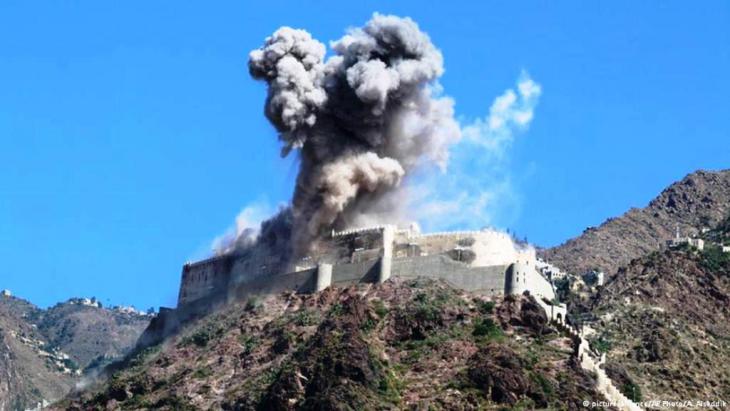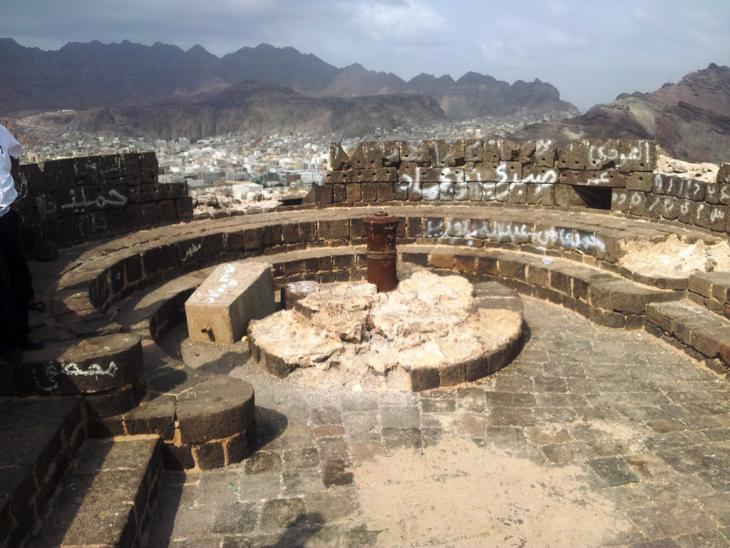Treasures of humanity under threat

Yemen has been through many wars and conflicts, both political and armed, and each time the country's numerous historic monuments have suffered. They have been damaged or looted, and their artefacts have been smuggled out of the country. This is particularly the case for sites within conflict areas. Often the relics themselves become battlegrounds, when they are used strategically by the parties involved in the conflict, and then become a target for the enemy.
Even when Yemen was the scene of armed disputes between Al-Qaeda and the Yemeni army, the military had already started using historic sites, buildings and towns, or even museums as bases, which led to robbery and damage. And the wider the current conflict spreads, the more danger is posed to old towns and other historic locations where combat groups have entrenched themselves - with catastrophic consequences.
The "Amiriya" in the city of Radaa is one of Yemen's most significant mosques and madrasas. It was built in 1504, under King Amir bin Abdalwahhab of the Tahirid dynasty. It won the Aga Khan medal for the restoration of Islamic sites, and was nominated for the UNESCO World Heritage list.
But it suffered severe damage in fighting between "Ansar al-Sharia", Al-Qaeda and the Yemeni army at the end of 2011. Parts of Radaa's city wall, which date back to the era of the Himyarite King Shamar Yahraash in the 3rd century A.D., were also damaged when Houthi militias and Al-Qaeda groups fought there last year.

Since the current war, named the "Storm of Resolve", began raging in Yemen in late March, Yemeni cultural assets have been targeted by all warring parties: the Houthis, the "people's resistance", and fighter planes belonging to the Saudi-led Arab League.
Long list of war damage
According to Muhannad Al-Sayani, the head of the Yemeni authority for antiquities and museums, dozens of ancient sites have been affected by the current war. However, in many cases it is impossible to verify the damage on site.
Completely or partly destroyed: in Sinhan, in the province of Sanaa, the mosque containing the tomb of Abderrazak ibn Hammam as-San'ani from the 9th century; the Dar al-Hassan in Damt from the pre-Islamic age in Dhalea; in Aden, the third floor of the national museum, which dates back to the era of Sultan Fadhl bin Ali al-Abdali (1912), as well as the Jauhara Mosque and the fortress of Sira, which were also bombed. Sira is one of Aden's most important castles, built in the 11th century.
In Taiz, the fortress of Qahira in particular was badly damaged. It was built by the Sulayhids in the 11th-12th century, and formed the heart of the city's settlement. Historically, it had an important defensive function, and served as the Ayyubids' residence when they governed Yemen from 1229 to 1454.
In Saada, the whole of the old town came under aerial bombardment, as did the mosque of Al-Hadi ilal-Haqq Yahya bin al-Hussein bin al-Qasim, the oldest and most important in the city. It dated back to the early 10th century.
The "weapon citadel" (Qasr al-Selah) in Sanaa, believed to have been erected on the ruins of the legendary Ghamdan Palace – hailed as an architectural miracle – was also bombed from the air.

The Ghamdan Palace was mentioned in the "Iklil" volume of the Yemeni chronicler Al-Hamdani, who lived in the 10th century. He said that King Seif bin dhi Yazan, the last Himyarite ruler in the 6th century, resided there. There has also been damage to individual houses in Sanaa's old town, as well as in the suburb of Fadj Attan, where the bombing was particularly heavy.
In Djauf, near Marib, large parts of the city wall of Baraqish (5th century B.C.) were damaged. In nearby Sirwah, cracks began appearing in large sections of the temple compound and the walls. The temple dates back to the Sabaean period and was excavated by a German mission. The largest known Sabaean inscription was discovered there in 2005. It was dated to the 7th century B.C.
UNESCO raises the alarm
The Yemeni antiquities authority, academics and civil society groups dedicated to the preservation of historical sites are already appealing to the parties involved in the conflict to stay away from historic places and spare them from damage, in order to save Yemen's remaining cultural assets, which are at the same time an inheritance for the whole of humanity.

In accordance with international agreements, the Hague Convention of 1954, and the UNESCO convention for the Protection of World Cultural Heritage of 1972, UNESCO was informed of damage to sites of outstanding cultural significance in Yemen. The Director-General of UNESCO Irina Bokova subsequently called on all parties in the conflict to protect Yemen's cultural heritage and "refrain from targeting, by shelling or by air strikes, or using for military purposes cultural heritage sites and buildings."
In 1984 UNESCO launched an international campaign to protect the old town of Sanaa, reconstructing the city wall, renovating numerous buildings and faithfully recreating original bridges and walkways in the old town. Several Yemeni cities have since been given the status of World Heritage Site: Shibam in Hadramaut (1982), the capital Sanaa (1986), Zabid (1993) and the island of Soqotra (2008). Saada was to be added to the list as well. Whether this is still possible remains uncertain, however. Saada was the Houthis' stronghold and has suffered heavy aerial bombardment by the Arab military coalition.
By Amida Sholan
© Qantara.de 2015
Translated by Ruth Martin
The author is a Yemeni expert on the archaeology and languages of the Arabian Peninsula.
